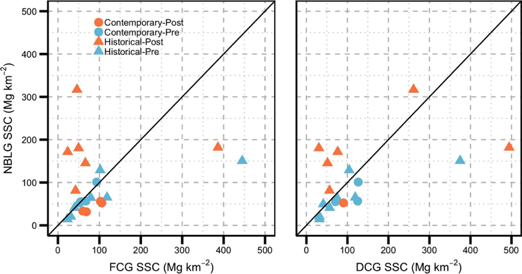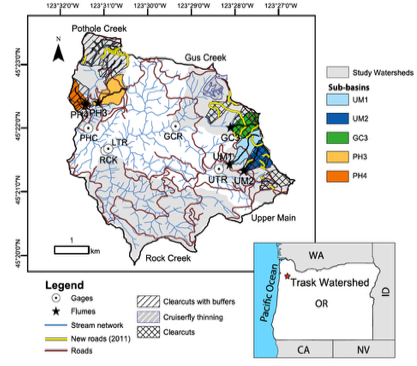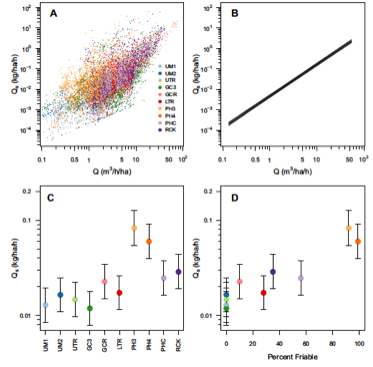Funded by
Geology and geomorphology influence suspended sediment transport and modulate increases following harvesting in temperate headwater catchments (2016-2017)

The purpose of this research was to examine the relative influence of basin setting (lithology and basin hysiographic variables) and forest management on SSY in a temperate headwater catchment in the Oregon Coast Range. Specifically, we analysed 6 years of data from the Trask watershed, which included harvested and unharvested sub-catchments and was underlain by heterogeneous lithologies, to achieve the following objectives:
1. Quantify how suspended sediment yield varies by catchment setting in forested headwater catchments;
2. Determine whether contemporary forest management practices impact annual suspended sediment yield in forested headwater catchments;
3. Determine whether there are natural catchment settings that result in different levels of vulnerability or resilience to increases in suspended sediment yield associated with disturbances (e.g., harvest activities).
Publications
17. Bywater-Reyes S., Segura C., Bladon K.D. 2017. Geology and geomorphology influence suspended sediment transport and modulate increases following harvest in temperate headwater catchments. Journal of Hydrology 548, 754-769.
20. *Bywater-Reyes S., Bladon K.D, Segura C. 2018. Relative influence of landscape variables and discharge on suspended sediment yields in temperate mountain catchments. Water Resources Research 54, 5126–5142. https://doi.org/10.1029/2017WR021728.
NATURAL AND HUMAN CONTROLS IN SUSPENDED LOAD (2016-2017)
The Alsea Watershed Study Revisited provided a unique opportunity to investigate and compare the suspended sediment response to contemporary forest harvesting practices (e.g., retention of riparian vegetation for provision of shade and reduction of sediment delivery and channel disturbance) with the impacts from historical (1960s) harvesting practices (e.g., no riparian vegetation retained, severe bank and channel disturbance, and intense broadcast burning for site preparation). The upper portion of the Needle Branch watershed was harvested in 2009, while the lower portion of the watershed was harvested in 2014 and 2015. Here, we present analysis of suspended sediment concentrations and yields across 11 years, from pre-treatment (WY 2006–2009), post-harvest Phase 1 (WY 2010–2014), and post-harvest Phase 2 (WY 2015–2016). Specifically, the objectives of this research were to address the following questions:
(a) What are the effects of contemporary harvesting practices on suspended sediment concentrations and yields?
(b) Are sediment yields lower from stands managed under contemporary harvest practices relative to historic practices?
Publications
18. Hatten J.A, Segura C, Bladon KD, Hale V.C, Ice G.G, Stednick J.D. 2018. Effects of contemporary forest harvesting on suspended sediment in the Oregon Coast Range: Alsea Watershed Study Revisited. Forest Ecology and Management. 408, 238 - 24

Suspended sediment yield of treated and reference watersheds from this study (contemporary-pre and –post) and the Original Alsea Watershed Study (historical-pre and –post). Historical data from Stednick (2008) and yields have been adjusted for differences in watershed area calculated historically and here (WS = old area (km2)/new area (km2)): FCG = 2.02/2.10, NBLG = 0.71/0.86, and DCG = 3.03/3.15.

A) All-site statistical analysis to predict suspended sediment yield (SSY; Qs) as a function of unit discharge (Q). B) discharge, Q, had the largest effect on SSY. C) When year-to-year heterogeneity was accounted for (random effect), site had an additional effect on SSY. D) The site effect increased as a function of percent friability.
Trask River Watershed Study location showing treatment and reference watersheds and nested headwater catchments. Suspended sediment and discharge data were collected at sub-basin (flumes) and watershed (gages) outlets.
Funded by

